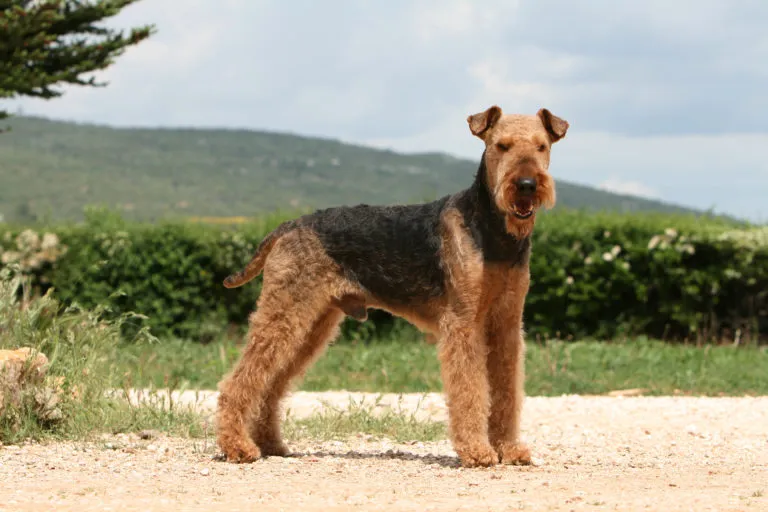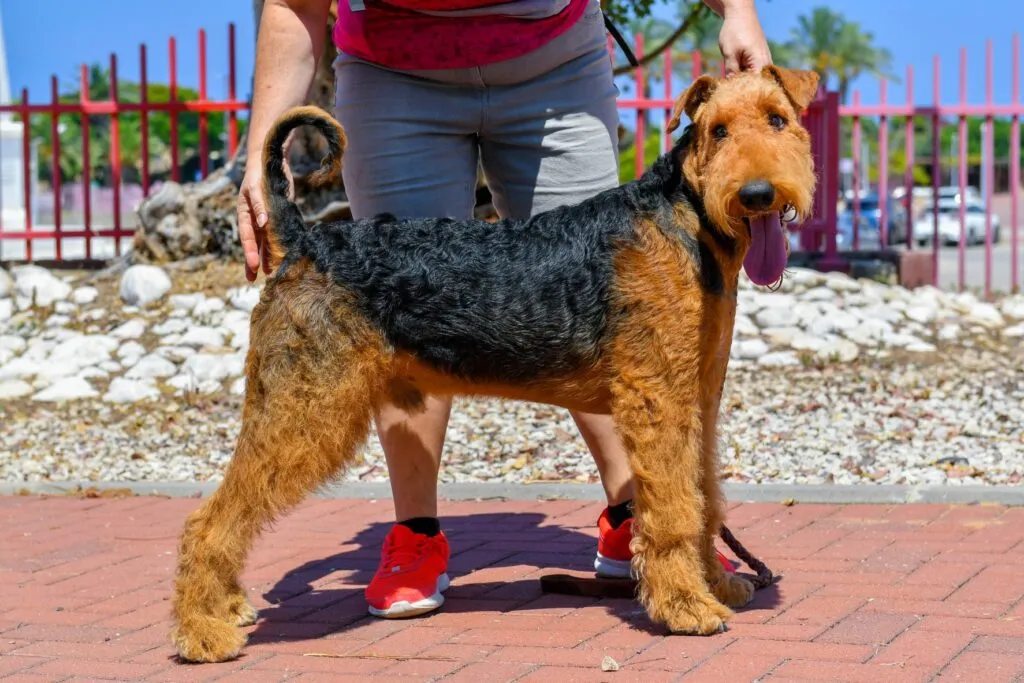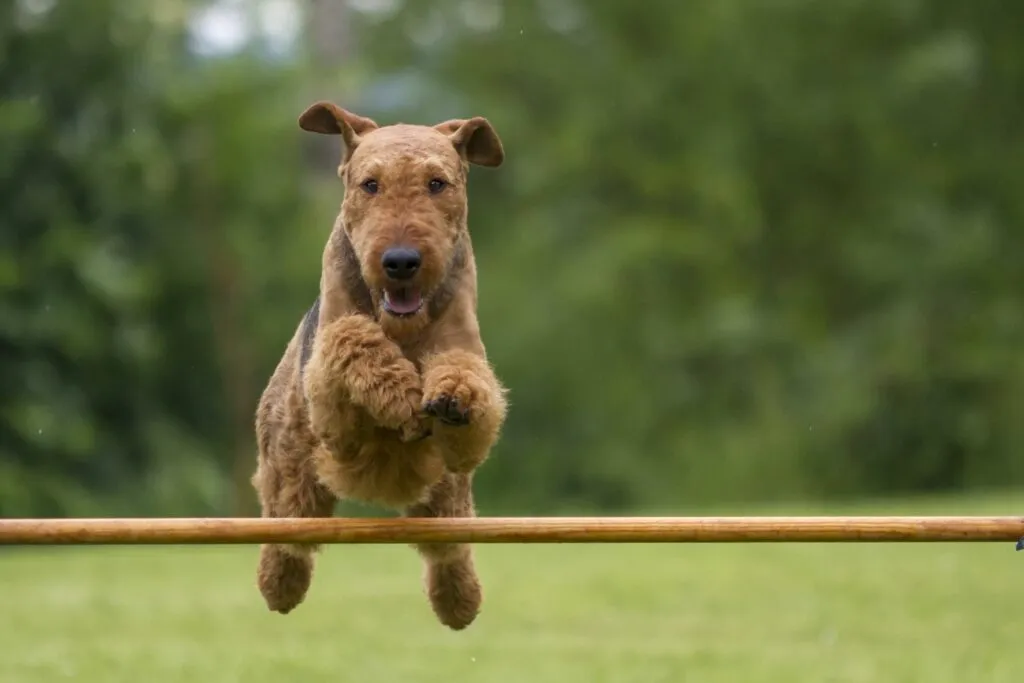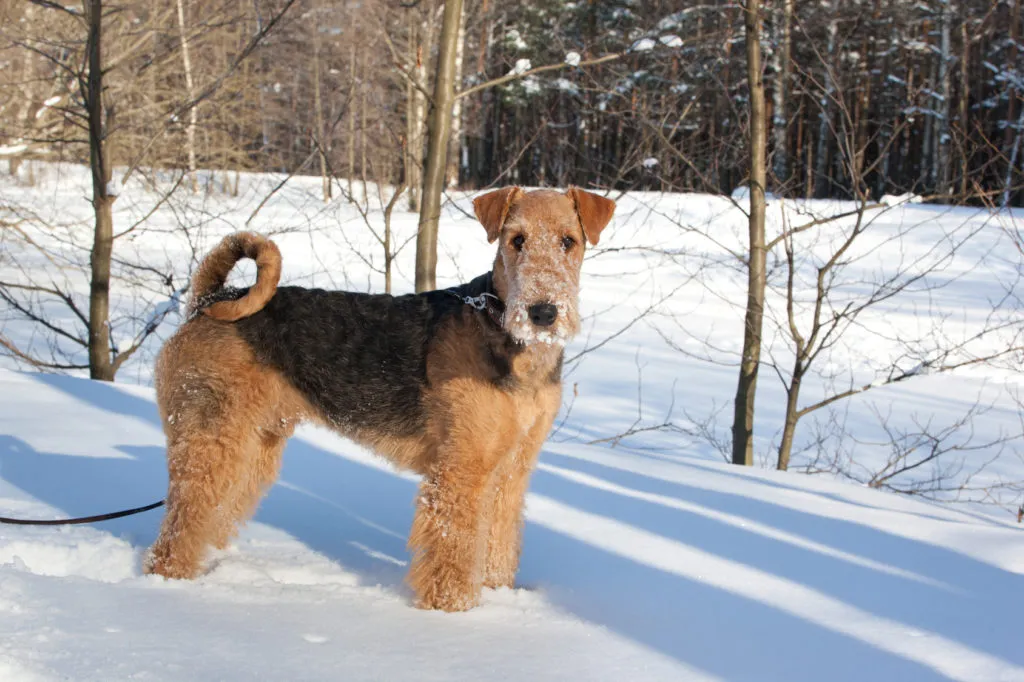Medium Size Poodle
The “King of Terriers,” as the Airedale Terrier is sometimes called, is one of the oldest and most versatile working dog breeds in the world. Today, this medium-sized breed, with its distinctive appearance and friendly, lively character, is a beloved family dog.

© Dogs / stock.adobe.com
The versatility and friendliness of the Airedale Terrier make it one of the most popular terriers.
The Airedale Terrier’s adventurous spirit and remarkable inner calm are reflected in its appearance. The alert look in its eyes, its often expectant ears, and the confident, upright tail show that this dog is ready for anything without being aggressive or nervous.
The Airedale has a robust, muscular, and compact build with a withers height ranging from 56cm to 59cm, making it one of the largest (English) terriers. These noble-looking dogs with their well-proportioned stature, open expression, and unique fur captivate dog enthusiasts worldwide.
The elongated head of the Airedale ends in a lush beard. The two-coloured fur, with a black saddle and tan body parts, gives this breed an unmistakable and friendly appearance.
The dense and wiry fur is best kept short to avoid a scruffy look. It can be slightly curly or wavy but should not be too curly or soft.
Together with the dense, short, soft undercoat, the double fur provides effective protection against water, wind, and cold. However, unlike most other breeds, the Airedale does not tolerate heat well, as it does not have a natural hair change.
 © PROMA / stock.adobe.com
© PROMA / stock.adobe.com
The lively expression and joyful expectation reveal it: This dog is ready for any adventure!
Whether on the dog sports field, on holiday, or during family outings: there’s hardly any activity that the Airedale Terrier won’t enjoy. Its lively and eager-to-learn nature, along with its balance and adaptability, make it easy for its people to fulfil these desires.
However, this does not mean it will be downgraded to a mere order-taker. The Airedale remains a terrier, complete with the breed’s typical independent spirit. It is rarely stubborn, but its high intelligence, strong self-confidence, and boldness allow it to “think for itself” and make certain demands.
The Airedale Terrier is simply a strong personality who knows what it wants. Top of its priority list are varied movement and activity opportunities that challenge it physically and mentally. The spirited and keen-to-learn dog cannot stand boredom.
Consistent training is crucial for this dominant-leaning terrier. Love, trust and understanding of its typical traits are the best foundation for training. Excessive harshness (or even violence) will likely make the Airedale stubborn and counterproductive.
Luckily, this friendly Brit has a very open and people-oriented nature. This makes it easy for its owner to quickly earn its trust. To its family, it becomes an extremely affectionate and cooperative partner, easily motivated for playful training exercises.
 © PROMA / stock.adobe.com
© PROMA / stock.adobe.com
Thanks to its balanced nature and keen sense of play, the Airedale Terrier is an excellent family dog. As such, it brings lots of fun not only to children but also to adults.
Many Airedale Terriers remain playful clowns even in old age, delighting their people with their humour and carefree nature. They form especially close bonds with children, acting as both a funny playmate and a reliable protector. However, like any dog of its size, it should not be left alone with small children.
The Airedale is also very peaceful when encountering other dogs, making it suitable for a multi-dog household, provided early socialisation as a puppy is undertaken.
When living with smaller pets such as guinea pigs, hamsters, and rabbits, or cats, the terrier’s innate hunting instincts should be considered.
To keep your dog healthy, regular and appropriate coat care is essential. To maintain the colour and shine of the Airedale’s coat, it needs to be trimmed regularly. This removes dead hair and makes room for new healthy hair.
From six months old, the Airedale Terrier should be trimmed three to four times a year, roughly every three to four months. Alternatively, you can trim specific parts of the body every four weeks, for instance, the head, front and hind legs, back, neck, or rear. This way, your dog only needs to stay still for short periods instead of three to four hours for a full trim.
Owning an Airedale Terrier depends significantly on providing it with proper occupation and sufficient exercise, in addition to consistent training.
This lively and adventurous dog is not suitable for “couch potatoes”. Owners must also be sporty and have plenty of free time to spend outdoors with their dog. If this is the case, you will undoubtedly have lots of fun with the humorous Airedale.
Daily walks alone are not enough for this active dog. Daily walks should be supplemented with dog sports, hunting activities or other games.
These athletic dogs also make great companions for jogging, cycling, inline skating, or horse riding. Therefore, a house with its own garden suits the vibrant and joyful Airedale well.
 © Sabine Glässl / stock.adobe.com
© Sabine Glässl / stock.adobe.com
An essential factor that speaks for buying a purebred Airedale Terrier is its health. Reputable breeders have their breeding dogs tested for common hereditary diseases before breeding. The results are documented and can be viewed anytime.
Fortunately, the number of serious breed-specific diseases in Airedale Terriers is quite low, excluding “show breedings” focused solely on appearance rather than health or character stability.
Currently, tests for hip dysplasia (HD), elbow dysplasia (ED), and progressive retinal atrophy (PRA) are conducted for breeding Airedales. Additionally, it is advisable to test the genetic material for the hereditary disease “Juvenile Nephropathy” (JRD, English “juvenile renal disease”), which is relatively common in Airedales and can lead to fatal kidney failure.
Airedale Terriers usually tolerate any food very well. If your dog does not have allergies, is not overweight and does not have any conditions requiring special diet food, you are free to decide what diet suits you and your dog best.
Do you have the time to cook daily for your dog? Are you interested in composing the food yourself and purchasing high-quality ingredients? Or do you prefer ready-made food that is quick to prepare and reliable?
You can feed your dog healthily with any type of dog food, so do not be swayed by opinions in internet forums or dog parks. If you are unsure, speak to your vet or experienced terrier breeders.
For more on dog nutrition, see the Nutrition zooplus Magazine.
In the rather harsh climate of Yorkshire, the origin of the Airedale Terrier, the breed’s sensitivity to heat was never a problem. As a dog of farmers, hunters, miners and factory workers, it needed robust fur that allowed it to reliably perform its varied tasks.
Known primarily as a working or waterside terrier, the versatile Airedale Terrier hunted otters and partridges, as well as pheasants and badgers. It also excelled at catching rats, driving cattle, herding tasks, and guarding.
The breed developed around the mid-19th century. The name “Airedale” comes from the Aire River in Yorkshire and the word “dale” (valley).
The first representatives likely resulted from crosses between other English terriers and larger otterhounds. It is also believed that Gordon Setters and Scottish Sheepdogs were involved in the breed’s development.
The Airedale Terrier was first recognised as an independent breed at a dog show in 1880. Two years later, the first pedigree records were made in the British Kennel Club. In 1886, the breed was officially recognised.
The unwavering work ethic, fearless courage, and high reliability & loyalty quickly earned the large terrier various roles.
The Airedale Terrier became renowned as an excellent messenger, service and medical dog, used by police, military and the Red Cross worldwide. It also made a fine companion to the sophisticated ladies of London in the late 19th century.
 © annatronova / stock.adobe.com
© annatronova / stock.adobe.com
The Airedale Terrier’s versatility soon earned recognition beyond British borders, making it one of the most widespread terrier breeds today.
Finding a breeder should not be a problem for interested parties. However, is this breeder right for you? The decision depends on more than just the distance between the breeder and your home.
Firstly, everyone in your family should agree on getting a dog, particularly the Airedale Terrier breed. A child’s fondness for the neighbour’s dog is not a strong enough reason to get a puppy.
Ensure you understand the responsibilities of owning an Airedale Terrier, especially the time required for its physical and mental engagement. If you travel frequently or have a demanding job, reconsider getting a dog.
Does this not apply to you? Is your family convinced that the Airedale Terrier is the right choice? Great! Before purchasing, visit several breeders.
This way, you can judge the breeder’s credibility and breeding conditions. A personal conversation will quickly reveal if you and the breeder align on breed characteristics, care, and training.
A credible breeder will invite you to their home, willingly show you the breeding facility, but usually not introduce the puppies at the first meeting due to their young age or to prevent hasty decisions based on their cuteness.
Consider these five points when visiting an Airedale Terrier breeder:
Fans of the Bearded Collie agree that those who aren't familiar with this dog breed simply have to get acquainted with it. And those who have experienced how a Bearded Collie bolts across meadows with its flowing fur, how it rolls around full of energy and joy and how it attentively and observantly takes into account its owners wishes become simply addicted to this original dog breed and its unique charm.
The Goldendoodle isn't a breed, but a pairing between Golden Retrievers and Medium or Standard Poodles. Marketed as a low-maintenance dog for allergy sufferers, this hybrid is enjoying increasing popularity amongst dog lovers, similar to the Labradoodle.